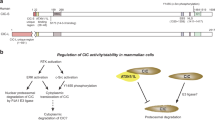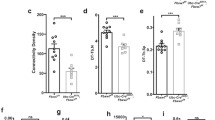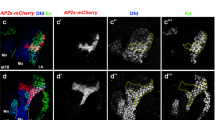Abstract
The transcription factor CBP, originally identified as a coactivator for CREB1,2, enhances transcription mediated by many other transcription factors3–7. Mutations in the human CBP gene are associated with Rubinstein–Taybi syndrome, a haploinsufficiency disorder characterized by abnormal pattern formation8, but the mechanism by which decreased CBP levels affect pattern formation is unclear. The hedgehog (hh) signalling pathway is an important determinant of pattern formation, cubitus interruptus (ci), a component in hh signalling, encodes a transcription factor homologous to the Gli family of proteins9 and is required for induction of the hh-dependent expression of patched (ptc), decapentaplegic (dpp) and wingless (wg)10. Haploinsufficiency for the ci-related transcription factor Gli3 causes phenotypic changes in mice (known as 'extra-toes)11 and humans (Greig's cephalopolysyndactyly syndrome)12 that have similarities to Rubinstein-Taybi syndrome. Here we show that Drosophila CBP (dCBP) functions as a coactivator of Ci, suggesting that the dCBP-Ci interaction may shed light on the contribution of CBP to pattern formation in mammals.
This is a preview of subscription content, access via your institution
Access options
Subscribe to this journal
Receive 51 print issues and online access
$199.00 per year
only $3.90 per issue
Buy this article
- Purchase on Springer Link
- Instant access to full article PDF
Prices may be subject to local taxes which are calculated during checkout
Similar content being viewed by others
References
Chrivia, J. C. et al. Phosphorylated CREB binds specifically to the nuclear protein CBP. Nature 365, 855–859 ( 1993).
Kwok, R. P. S. et al. Nuclear protein CBP is a coactivator for the transcription factor CREB. Nature 370, 223–226 ( 1994).
Arias, J. et al. Activation of cAMP and mitogen-responsive genes relies on a common nuclear factor. Nature 370, 226–229 ( 1994).
Bannister, A. J. & Kouzarides, T. CBP-induced stimulation of c-Fos activity is abrogated by E1A. EMBO J. 14, 4758–4762 ( 1995).
Kamei, Y. et al. A CBP integrator complex mediates transcriptional activation and AP-1 inhibition by nuclear receptors. Cell 85, 403–414 ( 1996).
Dai, P. et al. CBP as a transcriptional coactivator of c-Myb. Genes Dev. 10, 528–540 ( 1996).
Bhattacharya, S. et al. Cooperation of Stat2 and p300/CBP in signalling induced by interferon-α. Nature 383, 344–347 ( 1996).
Petrij, F. et al. Rubinstein-Taybi syndrome caused by mutations in the transcriptional co-activator CBP. Nature 376, 344–347 ( 1996).
Orenic, T. V., Slusarski, D. C., Kroll, K. L. & Holmgren, R. A. Cloning and characterization of the segment polarity gene cubitus interruptus dominant of Drosophila. Genes Dev. 4, 1053–1067 ( 1990).
Blair, S. S. Hedgehog digs up an old friend. Nature 373, 656–657 ( 1995).
Hui, C.-C. & Joyner, A. L. A mouse model of Greig cephalopolysyndactyly syndrome: the extra-toes mutation contains an intragenic deletion of the Gli3 gene. Nature Genet. 3, 241–245 ( 1993).
Vortkamp, A., Gessler, M. & Grzeschik, K.-H. GLI3 zinc-finger gene interrupted by translocations in Greig syndrome families. Nature 352, 539–540 ( 1991).
Alexandre, C., Jacinto, A. & Ingham, P. W. Transcriptional activation of hedgehog target genes in Drosophilais mediated directly by the Cubitus interruptus protein, a member of the GLI family of zinc finger DNA-binding proteins. Genes Dev. 10, 2003–2013 ( 1996).
Locke, J. & Tartof, K. D. Molecular analysis of cubitus interruptus (ci) mutations suggests an explanation for the unusual ci position effects. Mol. Gen. Genet. 243, 234–243 ( 1994).
Slusarski, D. C., Motzny, C. K. & Holmgren, R. Mutations that alter the timing and pattern of cubitus interruptus gene expression in Drosophila melanogaster. Genetics 139, 229–240 ( 1995).
Schuske, K., Hooper, J. E. & Scott, M. P. patched overexpression causes loss of wingless expression in Drosophila embryos. Dev. Biol. 164, 300–311 ( 1994).
Dominguez, M., Brunner, M., Hafen, E. & Basler, K. Sending and receiving the hedgehog signal: control by the Drosophila Gli protein cubitus interruptus. Science 272, 1621–1625 ( 1996).
Hama, C., Ali, Z. & Kornberg, T. B. Region-specific recombination and expression are directed by portions of the Drosophila engrailed promoter. Genes Dev. 4, 1079–1093 ( 1990).
Brown, N. H. & Kafatos, F. C. Functional cDNA libraries from Drosophila embryos. J. Mol. Biol. 203, 425–437 ( 1988).
Johnson, R. L., Grenier, J. K. & Scott, M. P. patched overexpression alters wing disc size and pattern: transcriptional and post-transcriptional effects on hedgehog targets. Development 121, 4161–4170 ( 1995).
Tabata, T. & Kornberg, T. B Hedgehog is a signaling protein with a key role in patterning Drosophila imaginal discs. Cell 76, 89–102 ( 1994).
Xu, T. & Rubin, G. M. Analysis of genetic mosaics in developing and adult Drosophila tissues. Development 117, 1223–1237 ( 1993).
Vojtek, A. B., Hollenberg, S. M. & Cooper, J. A. Mammalian ras interacts directly with the serine/ threonine kinase raf. Cell 74, 205–214 ( 1993).
Krasnow, M. A., Saffman, E. E., Kornfeld, K. & Hogness, D. S. Transcriptional activation and repression by Ultrabithorax proteins in cultured Drosophila cells. Cell 57, 1031–1043 ( 1989).
Thummel, C. S., Boulet, A. M. & Lipshitz, H. D. Vectors for Drosophila P-element-mediated transformation and tissue culture transfection. Gene 74, 445–456 ( 1988).
Author information
Authors and Affiliations
Rights and permissions
About this article
Cite this article
Akimaru, H., Chen, Y., Dai, P. et al. Drosophila CBP is a co-activator of cubitus interruptus in hedgehog signalling. Nature 386, 735–738 (1997). https://doi.org/10.1038/386735a0
Received:
Accepted:
Issue Date:
DOI: https://doi.org/10.1038/386735a0
This article is cited by
-
Molecular characterization and modulated expression of histone acetyltransferases during cold response of the tick Dermacentor silvarum (Acari: Ixodidae)
Parasites & Vectors (2023)
-
Epigenetic mechanisms to propagate histone acetylation by p300/CBP
Nature Communications (2023)
-
Targeting of SET/I2PP2A oncoprotein inhibits Gli1 transcription revealing a new modulator of Hedgehog signaling
Scientific Reports (2021)
-
Lifespan-increasing drug nordihydroguaiaretic acid inhibits p300 and activates autophagy
npj Aging and Mechanisms of Disease (2019)
-
Epigenetic modifications acetylation and deacetylation play important roles in juvenile hormone action
BMC Genomics (2018)
Comments
By submitting a comment you agree to abide by our Terms and Community Guidelines. If you find something abusive or that does not comply with our terms or guidelines please flag it as inappropriate.



